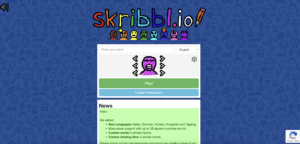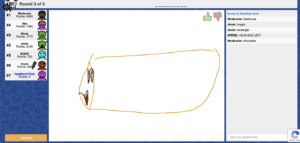The name of the game that I played was skribbl.io, where the group guesses the subject of an individual’s drawing. Skribbl.io was created by ticedev, and the game is published on both mobile and desktop clients for both on-the-go and home gaming.
The target audience of skribbl.io spans multiple age groups, as it takes advantage of the fact that drawing is a universal language. Young adults can play this in a casual setting, and children can also play the game with their friends. The messaging and website scheme hint that the game is catered towards younger people, as it features a basic face customization capability as well as colorful animated website layout.
The multiplayer game supports up to 12 people, and groups with as few as 2 players can even game. The formal elements of the game, while understated, is clear through their website formatting – it’s a multiplayer drawing and guessing game.
The game calls for players up to 12, where each player randomly alternates roles between the drawer and guesser. The drawer’s task is to create a picture recreation of a random word they are given – the better they draw, the easier it is for the guessers to understand what the actual word is. Drawers are incentivized by the fact that if they draw the picture well, guessers will be able to get the word quickly and they will earn extra points for speed. On the other hand, guessers are tasked with guessing the secret word that the drawer is guessing. The faster they guess the word correctly, the more points they earn. Thus, both the drawer and guesser are incentivized to work collaboratively, as both are motivated by speed and time. The game is a clear representation of a game with a Construction objective, with formal elements such as collaboration and teamwork. Rounds in skribbl.io are simply a randomization of the next drawer, so every round starts with a completely different master drawer and a swapping of roles. There are a max total of some number of rounds, and players want to amass as many points as possible to be on the leaderboard following the conclusion of the game. In a way, this makes the game both collaborative and competitive.
The game’s fun mechanics lie in its ability to capture the essence of Expression. Similar to games like Charades, skribbl.io functions on its ability to encourage players to creatively find ways to draw words and deconstruct the secret words on their drawing canvas. Additionally, the game encourages Fellowship, where the guessers and drawers are incentivized by the same end goal of guessing the word as fast as possible. Few games have Expression as its main mechanism of fun, so it makes the game quite compelling!
The game could be improved by having challenge rounds or a different form in the round structure – after a while of the same exact formatted rounds, the game gets quite stale as users are not continuously given new stimuli and interesting mechanics. However, this could also work to the game’s advantage as its premise is quite simple and non-complicated to understand. Skribbl.io is quite similar to Charades and Heads Up, where users work with team members to guess a secret word. They’re both structured to by information withholding, where only one team member knows the actual word. This game is differentiated by others within its genre, as it heavily relies on the drawing mechanism for guessing rather than acting or circumlocution, which makes skribbl.io unique in its genre. I think that skribbl.io is much more fun than Charades, as I love drawing and this game is an extension of that! In this game, users do not need to get very vulnerable, as they are simply drawing word prompts – in a way, it can be said that users are revealing their art technique and skill level!





